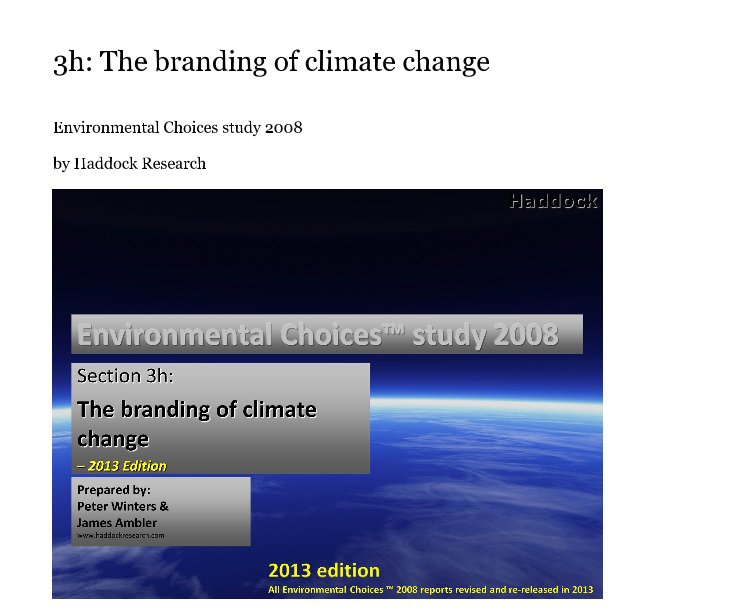3h: The branding of climate change
Environmental Choices study 2008
by Haddock Research
This is the price your customers see. Edit list price
About the Book
Environmental Choices Report 3.h – The branding of climate change
This report is about how branding can be used to motivate people to work towards a low-carbon economy and embrace low-carbon products and services. Perhaps the most common environmental idea is that of “beautiful nature”. The idea of “beautiful planet earth” is how Al Gore starts and finishes “An Inconvenient Truth”. Greenpeace urge action on climate change with images of polar bears. But how powerful is this idea? And is it compelling amongst a broad spectrum of people? In this report we focus on testing 6 different branding ideas to see how powerful people find them to be - including a test of the “beautiful nature” idea.
This is one of 14 reports from the Environmental Choices study conducted in Canada, England and the US. The original research was conducted in late 2008, and the reports have had a major upgrade for the '2013 edition' – complete with new analyses, easier navigation, better distribution through books and via iPad, and new pricing.
With Environmental Choices, our general goal has been about understanding how much ‘concern about climate change’ makes a difference to people in the choices they make and the policies they would support. We can see from this research that there are great divisions in the public’s attitudes towards climate change; from the most concerned ‘Climate Citizens’, to the moderately concerned ‘Mild Greens’, to the dismissive and/or unconcerned ‘Sceptics & Uninvolved’. Throughout the reports we examine how these different viewpoints correlate with, and predict other attitudes, interests and behaviours. By creating this robust, international categorical variable to describe ‘climate change concern’ we have a way of measuring the consumer value of low-carbon products, across multiple product categories.
This report is about how branding can be used to motivate people to work towards a low-carbon economy and embrace low-carbon products and services. Perhaps the most common environmental idea is that of “beautiful nature”. The idea of “beautiful planet earth” is how Al Gore starts and finishes “An Inconvenient Truth”. Greenpeace urge action on climate change with images of polar bears. But how powerful is this idea? And is it compelling amongst a broad spectrum of people? In this report we focus on testing 6 different branding ideas to see how powerful people find them to be - including a test of the “beautiful nature” idea.
This is one of 14 reports from the Environmental Choices study conducted in Canada, England and the US. The original research was conducted in late 2008, and the reports have had a major upgrade for the '2013 edition' – complete with new analyses, easier navigation, better distribution through books and via iPad, and new pricing.
With Environmental Choices, our general goal has been about understanding how much ‘concern about climate change’ makes a difference to people in the choices they make and the policies they would support. We can see from this research that there are great divisions in the public’s attitudes towards climate change; from the most concerned ‘Climate Citizens’, to the moderately concerned ‘Mild Greens’, to the dismissive and/or unconcerned ‘Sceptics & Uninvolved’. Throughout the reports we examine how these different viewpoints correlate with, and predict other attitudes, interests and behaviours. By creating this robust, international categorical variable to describe ‘climate change concern’ we have a way of measuring the consumer value of low-carbon products, across multiple product categories.
Author website
Features & Details
- Primary Category: Business & Economics
-
Project Option: Standard Landscape, 10×8 in, 25×20 cm
# of Pages: 124 - Publish Date: Oct 25, 2013
- Language English
- Keywords Climate change, low carbon, polar bear, Best/Worst analysis, Alignment scores, cluster analysis, branding, consumer, profiling, CHAID
See More


